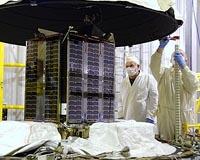 |
Bonn, Germany (SPX) Oct 27, 2009 From 21 to 23 October 2009, experts from all over the world met on the campus of the United Nations in Bonn for the 3rd International UN-SPIDER Bonn Workshop - with the topic 'From Concepts to Application'. This international workshop on the use of space technologies for disaster management is organised by the German Aerospace Center (Deutsches Zentrum fur Luft- und Raumfahrt; DLR) and the United Nations Office for Outer Space Affairs (UNOOSA) and is supported by the Secretariat of the United Nations Convention to Combat Desertification (UNCCD). Satellite-supported information about disaster areas after earthquakes or floods is a huge support for relief units on location. Especially important are the position of the centre of the catastrophe and an overview of the intact infrastructure in the direct vicinity. Only with this knowledge can relief efforts be organised and coordinated promptly. The UN-SPIDER office (SPace-based Information for Disaster Management and Emergency Response) in Bonn ensures that the required data is quickly accessible and thus supports disaster management from space. A priority of this year's workshop is the concrete implementation of concepts for applications and projects in the field of disaster management with the aid of space technologies. Earth observation satellites and other space-based technologies are assisting in the development of solutions in many areas of disaster management. Climate change and the increase in desert areas represent a special challenge in this area. For the first time, UN-SPIDER is also targeting preventative measures prior to a disaster and is thus expanding previous efforts to utilise satellite data for direct humanitarian relief operations and emergency measures. This expansion addresses the reduction of risk and the provision of early warnings. These are components of the disaster management cycle, as are rescue measures and reconstruction.
Successful collaboration between DLR and UN-SPIDER "We are looking back on a successful collaboration between DLR and UN-SPIDER in providing satellite data for disaster areas and carrying out technical consulting missions for developing countries", said Prof. Johann-Dietrich Worner, chairman of DLR, at the opening of the workshop. "As a result of the intensive exchange of information and specialised knowledge, the cornerstone has been laid for further cooperation in the future", Prof. Worner continued. The Namibian ambassador in Germany, Neville Gertze, recognised this support for his country, which has been increasingly affected by flood disasters in recent years. Over the course of the three-day workshop, the approximately 150 participants will concern themselves with the exchange of practical experiences in the application of space technology and with the notion of further developed services for the purpose of rapidly supplying information. Furthermore, applications on the topics of climate change and disaster medicine will be on the agenda. Also attending as guests are the Head of the Permanent Mission of the UN in Vienna - Ambassador Rudiger Ludeking - and Margitta Wulker-Mirbach - Head of the Division of Development Policy/United Nations in the German Federal Ministry of Economics and Technologies (Bundesministerium fur Wirtschaft und Technologie; BMWi) and a supporter of UN-SPIDER from the beginning. In addition, in connection with the workshop, Prof. Worner opened the exhibition 'What a Sight - Space Looking out for World Heritage' in the UN building in Bonn. In this exhibition, DLR - in collaboration with UNESCO - shows satellite images of world heritage sites worldwide. The pictures provide unique views of the Earth, but also show the marks that man has left behind on our planet. The images include the pyramids of Giza, the Museum Island (Museumsinsel) in Berlin and the Florida Everglades. The exhibition has previously visited Paris, Brussels and Cologne.
UN-SPIDER office Among other things, what is required are up-to-date satellite images of disaster areas for the logistical support of relief efforts, archived time series of satellite images - for trend analysis and risk assessment - and data transfer via satellite for the early warning systems' local measuring stations. Share This Article With Planet Earth
Related Links German Aerospace Center (DLR) Space Technology News - Applications and Research
 Final Look At ESA's SMOS And Proba-2 Satellites
Final Look At ESA's SMOS And Proba-2 SatellitesParis, France (ESA) Oct 22, 2009 As preparations for the launch of SMOS and Proba-2 continue on schedule, the engineers and technicians at the Russian launch site say goodbye as both satellites are encapsulated within the half-shells of the Rockot fairing. Volker Liebig, ESA's Director of Earth Observation Programmes, said, "Today, with the encapsulation of the SMOS satellite in the launcher fairing, we have made an ... read more |
|
| The content herein, unless otherwise known to be public domain, are Copyright 1995-2009 - SpaceDaily. AFP and UPI Wire Stories are copyright Agence France-Presse and United Press International. ESA Portal Reports are copyright European Space Agency. All NASA sourced material is public domain. Additional copyrights may apply in whole or part to other bona fide parties. Advertising does not imply endorsement,agreement or approval of any opinions, statements or information provided by SpaceDaily on any Web page published or hosted by SpaceDaily. Privacy Statement |